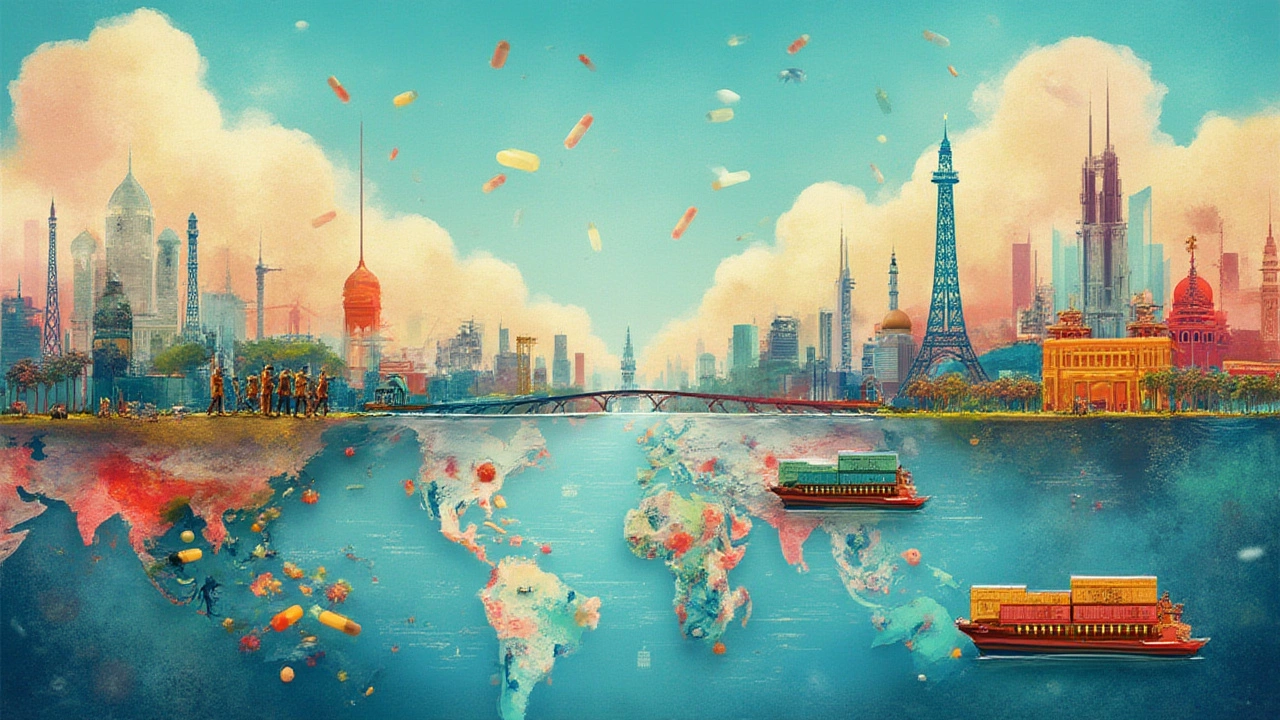
Walk through any pharmacy in Sydney and you’ll probably find medicines made in India. This isn’t a coincidence—India isn’t called the “pharmacy of the world” just for fun. A massive part of the medicine you see in hospitals, clinics, or even the stuff lurking at the bottom of your first-aid kit? It’s got Indian fingerprints on it. What’s wild is that the country’s pharmaceutical landscape is utterly dominated by just a handful of giants—the so-called "Big 4"—who drive not just local, but global trends.
The Titans of Indian Pharma: Who Are the Big 4?
The Indian pharmaceutical industry isn’t a bunch of small players fighting for scraps. There’s a clear pecking order, and four names consistently pop up at the top: Sun Pharmaceutical Industries, Dr. Reddy’s Laboratories, Cipla, and Lupin. These guys aren’t just household names in their own country—they’ve got outposts, labs, and factories scattered all over the globe. By revenue, R&D, and international reach, these are the brands doctors and regulators actually care about. So, why these four?
Look at Sun Pharma, for starters. Founded back in 1983 with a tiny team and a single product, it’s now the largest pharma company in India and among the world’s top 10 in generics. Sun’s footprints cover 100 countries, and they ship everything from basic antibiotics to complex cancer treatments. Dr. Reddy’s, meanwhile, is basically a household name for anyone who’s ever popped a generic painkiller. The company pioneered exports and built a global reputation, boasting more than 190 medications approved by the USFDA alone. Cipla has a special spot, particularly as the company that helped make HIV/AIDS drugs affordable for millions overnight—it’s got a real hero complex. Lupin, last but not least, took off from asthma drugs but now produces critical meds across the board, selling in 100+ countries, with plenty of awards for innovation along the way.
What unites all four? Market dominance, relentless innovation, and a focus on exporting medicines at prices that often undercut the competition. And it’s not just about cash—these brands have set standards in clinical trials, drug safety, and corporate responsibility that even Western multinationals try to keep up with. Here’s a quick look at some of their stats:
| Company | Founded | 2024 Revenue (INR Crore) | Global Presence (Countries) | Key Therapeutic Areas |
|---|---|---|---|---|
| Sun Pharmaceutical | 1983 | 43,400 | 100+ | Cardiology, Oncology, Psychiatry, Dermatology |
| Dr. Reddy’s Laboratories | 1984 | 25,300 | 66 | Generics, Biologics, Oncology, Anti-infectives |
| Cipla | 1935 | 22,750 | 80+ | Respiratory, HIV/AIDS, Oncology, Anti-malarials |
| Lupin | 1968 | 19,650 | 100+ | Cardiology, Diabetes, Asthma, Anti-infectives |
How the Big 4 Changed Indian Pharma’s Game
Flip the clock back to the early 80s and medicine in India looked totally different. Most drugs were imported. Patents were iron-clad. Prices were sky-high. Then these four companies barreled in, took risks, and started churning out affordable versions that changed the rules—not through copying, but clever R&D and relentless lobbying for relaxed patent laws. The result: prices crashed and medicine became accessible to common folks, not just the well-off.
Sun Pharma jumped ahead with a focus on chronic and lifestyle diseases, snapping up global brands left and right. When they bought Ranbaxy back in 2014 for $4 billion, it sent a shockwave. Suddenly, India’s pharma landscape consolidated and everyone looked to Sun for the next big move. Dr. Reddy’s got its street cred by breaking into tough markets—especially the US—facing all the regulatory hoops and FDA headaches, and still coming out ahead with a full arsenal of generics. Cipla’s story is all heart and hustle: in 2001, they started selling HIV/AIDS drugs at under $1 a day, making global headlines and saving lives while Western drug makers were still haggling over patents. Lupin, the underdog for years, got its break with asthma inhalers and antibiotics—suddenly you saw their options everywhere, from Mumbai to Manchester.
This wasn’t just good business. The Big 4 redefined what “Made in India” could mean—reliable, high-quality, and cheap enough for folks in both poor and rich countries. By 2024, India supplied over 20% of the world’s generic medicines. The troika of cost, reach, and reliability became the gold standard, forcing even big American and European players to step up or step out.

The Global Expansion: How Indian Pharma Became a Powerhouse
Getting a drug approved in Europe or the USA isn’t easy. You’ve got to meet the world’s strictest standards, pass endless checks, and navigate enough paperwork to sink a ship. The fact that all four big companies have USFDA-certified plants—and that three out of every ten new generics prescribed in America are from India—says something about their quality game. They’ve invested billions in research centers from Boston to Basel, and they don’t just sell pills—they’ve got deals with hospitals, clinics, and governments everywhere.
Sun Pharma owes half its sales to outside India, with the US market as their biggest cash cow. Dr. Reddy’s is knee-deep in Russia, Eastern Europe, and even Africa, adjusting their lineup to every market and regulation. Cipla doesn’t just chase big profits—they have a unique humanitarian focus, often working with charities and government bodies to deliver drugs at rock-bottom prices during health crises. Lupin, which once relied on basic antibiotics, now makes everything from advanced biosimilars to pediatric medicines—even creating custom inhalers for developed and emerging countries alike.
Most folks don’t realize that Indian pharma companies are often the first to step in during shortages. For instance, during the early months of COVID-19, it was companies like Cipla and Dr. Reddy’s who scaled up production of remdesivir and hydroxychloroquine, shipping millions of doses at breakneck speed. The same story repeats after every global health scare—be it Ebola or new flu outbreaks—because these companies have the muscle and the capacity to deliver.
Innovation, Challenges, and Controversy
It’s not all rosy. The Big 4 push hard on innovation and R&D, yet they face plenty of criticism. For one, price wars can get ugly—companies sometimes cut costs so much that quality can slip, leading to recalls or bans from picky regulators like the FDA. The drive to bring new drugs to market fast can result in lawsuits, especially around intellectual property. The 2010s saw a wave of such battles as Western giants tried to shut Indian companies out, fearing price erosion in their home markets.
Still, these companies aren’t just copy-pasting formulas anymore. Sun Pharma now pours billions into research on advanced therapies like oncology and biologics, collaborating with some of the world’s top universities and research outfits. Dr. Reddy’s filed more than 800 patents in the last few years, many for new drug delivery systems. Cipla’s advanced respiratory devices are used across four continents, and Lupin’s work on biosimilars for rare diseases regularly makes headlines in medical journals. The industry’s push towards sustainability is picking up, too. Plants that recycle over 80% of their water, massive investments in solar energy, and contamination monitoring—these aren’t just future promises, they’re happening right now.
Controversy, though, never strays far. Indian pharma’s rapid growth often attracts criticism for aggressive generics lobbying, inconsistent quality in lesser-known companies, and the ever-present debate over balancing profit with patient access. And yet, when another outbreak hits or medicine shortages bite, regulators and hospitals look to India—usually to the Big 4 first—for quick solutions. These companies aren’t just industry leaders, they’ve become global safety nets.

Tips for Navigating the Indian Pharma Industry
Diving into Indian pharma for business, research, or even as a consumer? Having the big picture helps. Here are a few practical tips, whether you’re buying products, investing, or just trying to wrap your head around the field:
- Check for regulatory approvals. If you see USFDA, EMA, or WHO-GMP tags, that’s a good sign for quality—especially in medicine exports.
- Not all companies have equal global reach. The Big 4 are safest bets for consistent supply and international standards.
- Watch the news for export bans or product recalls—these can quickly impact supply chain reliability, especially for hospitals and large consumers.
- Want stable investments? The Big 4 often weather economic swings better than smaller players, thanks to diversity in revenue and product mix.
- Bulk medicines or generics from these companies often mean sharp savings without compromising on quality, particularly for chronic diseases like diabetes or hypertension.
- Be alert to shifts in Indian patents law and international agreements, as these impact what drugs become available in or from India.
If you’re working in healthcare, knowing the ins and outs of these companies pays off in smooth procurement and lower costs. Researchers often find more flexibility and partnership opportunities here than with Western giants, too. And for patients, knowing a med comes from a Big 4 manufacturer tends to mean fewer worries about safety or surprise shortages—they didn’t get to the top by cutting corners.